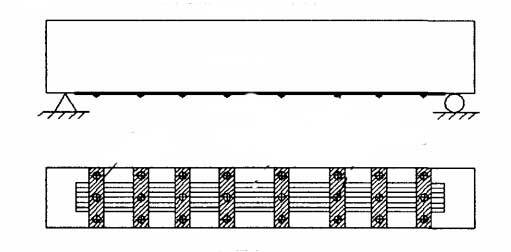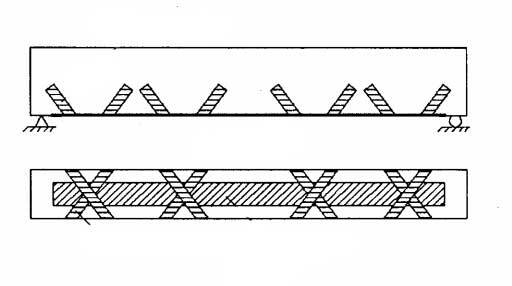Solutions
Horse Construction offers full range of structural strengthening materials with technical supports, documentation supports, products supports, project supports.
Compare the anchoring effect and applicable range of different anchoring methods in carbon fiber reinforcement
There are many reinforcement methods in the project, and the reinforcement of the members is divided into bending reinforcement and shear reinforcement. Whether it is flexural reinforcement or shear reinforcement, there is a very difficult problem: the peeling of the reinforcement material. Often due to the premature peeling of the reinforcement material, the damage has a significant brittleness, and the utilization rate of the reinforcement material is low, which cannot achieve the effect of reinforcement. Therefore, suitable anchoring measures are particularly important.
To resist bending reinforcement, because the end is often prone to stress concentration, the commonly used anchoring measure is to add U-shaped strips at the end to increase the anchoring performance.
To resist shear reinforcement, the commonly used anchoring measure is to attach additional restraint steel plates to the side of the beam to suppress the development of diagonal cracks. It can also strengthen the integrity of the U-shaped hoop, prevent the upper part of the U-shaped hoop from collapsing, and enhance the anchoring performance.
1 Comparison of U-shaped hoop anchoring and anchoring at the bottom of the beam
In the flexural reinforcement with carbon fiber sheet, u-shaped hoop anchoring or additional anchor bolt anchoring at the bottom of the beam can be adopted.

When the carbon fiber cloth starts to peel off, and when the peeling encounters the anchor bolt, it quickly passes over the anchor bolt, and the inhibitory effect of the anchor bolt is hardly felt. This is because there is a certain diameter difference between the expansion bolt and the hole punched. When the carbon fiber cloth is peeled off, the carbon fiber cloth will pull the anchor and deform laterally. When a certain lateral deformation is reached, the shear resistance of the anchor can be exerted. It can be said that the effect of the anchor bolt on suppressing the peeling of the carbon fiber cloth is not obvious, and when the peeling develops to a certain extent, the slip of the anchor fiber on the entire carbon fiber cloth can still have a certain suppression effect. Therefore, compared with the U-shaped hoop, the anchoring effect of the additional anchor bolt at the bottom of the beam is weaker.
2 Comparison between steel plate U-shaped hoop anchor and carbon fiber U-shaped hoop anchor
Steel plate u-shaped hoop anchoring is a rigid anchoring solution, while carbon fiber u-shaped hoop anchoring or other forms of carbon fiber anchoring are all flexible anchoring schemes. In the application of carbon fiber cloth reinforcement, for the flexible anchoring scheme using CFPR sheet, the stress of the CFPR sheet near the crack after the cracking of the concrete at the dangerous section increases rapidly, resulting in a higher concentration stress. In this way, the stress of the fibrous sheet material used for anchoring near the dangerous cross section is also increased. As the load increases, the fiber sheet at the anchoring area gradually tears, and finally the fiber sheet and the remaining anchoring sheet adhered to the beam side in the anchoring area are all peeled off instantly, and the reinforcing member is damaged. The rigid anchoring scheme is significantly better than the flexible scheme. Due to the characteristics of the material, the steel plate u-hoop will not have strip tearing like carbon fiber u-hoop, so the rigid anchoring method can better solve the problem of anchoring the CFPR sheet at the node.

In addition, to strengthen the carbon fiber sheet of low-strength concrete structure, the rigid anchoring scheme of steel plate u-shaped hoop is often used to obtain better anchoring effect. Because, within a certain range of concrete strength, the bond strength is controlled by the strength of the concrete. The lower the strength of the concrete, the lower the bond strength between them, and the more likely they are to peel off. When the steel plate u-shaped hoop is adopted as an additional anchoring measure, the carbon fiber reinforcement method can be used for the reinforcement of low-strength concrete beams, and the bearing capacity of the beams after reinforcement is greatly improved.

In the reinforcement of the carbon fiber sheet, because the carbon fiber sheet is much thicker than the carbon fiber cloth, so if the carbon fiber u-shaped hoop is used for anchoring, one layer is often not enough, and it is necessary to stick multiple layers to have a better anchoring effect. However, the multi-layer carbon fiber u-shaped hoop has the problems of impermeable adhesive layer and inconvenient construction. Therefore, the use of steel plate u-shaped hoop can achieve better anchoring effect, which is often a better choice. And it is obvious that due to the unidirectional stress performance of the carbon fiber material, at the corner of the U-shaped hoop, the mechanical performance of the steel plate u-shaped hoop is obviously superior to that of the carbon fiber U-shaped hoop.

However, the steel plate u-shaped hoop used for anchoring is generally thin, easily corroded, and affects the service life, so it needs to be protected and treated, which increases the complexity of construction. Moreover, the weight of the steel plate is larger than that of carbon fiber material, and it is more difficult to form than the carbon fiber u-shaped hoop. The requirements for the bonding surface are high, and the construction is not easy. It is difficult to ensure that the three sides exactly match the reinforced member, and it is difficult to ensure the quality of the paste. It is inferior to the carbon fiber u-shaped hoop.
3 Comparison of carbon fiber X-shaped hoop anchoring and carbon fiber U-shaped hoop anchoring

Since the carbon fiber cloth is a unidirectional force-bearing material, it has almost no load-bearing capacity in the direction perpendicular to the carbon fiber wire. Therefore, the X-shaped hoop can exert the strength of the hoop itself and transfer the longitudinal carbon fiber tensile force to the side of the beam, and can reduce the bonding shear stress at the interface of the carbon fiber at the bottom of the beam and the concrete at the same load to achieve the effect of preventing the carbon fiber from peeling. The anchoring effect of the U-shaped hoop is mainly achieved by the adhesive properties of the colloid and the resistance to small peeling normal stress. The anchoring of the X-shaped hoop exerts more of the strength of the carbon fiber hoop itself to resist the tensile force of the longitudinal carbon fiber, and transmits the force to a larger range to limit the peeling effect. The u-shaped hoop mainly relies on the adhesive shear stress of the adhesive layer at the bottom of the beam to resist the longitudinal carbon fiber tensile force. The u-shaped hoop itself cannot play a large role, nor can it transmit the tensile force to the side of the beam. Therefore, the anchoring effect of the X-shaped hoop is stronger than that of the U-shaped hoop.
When anchored with an x-shaped hoop, the blank area is still a blind spot for reinforcement, if a crack occurs in this blank portion. Due to the large area of the blank portion, the crack does not easily intersect with the X-shaped hoop. From the perspective of the probability of intersection with the crack, the X-shaped hoop is not as good as the U-shaped hoop.
Comparing the carbon fiber u-shaped hoop with other anchoring methods, it is found that the carbon fiber U-shaped hoop anchor is inherently not quite different from other anchoring methods, but its application in current engineering is more common than other anchoring methods. Because carbon fiber u-shaped hoops are much easier to construct than other anchoring methods, they are lighter in weight, less prone to corrosion, and have a larger anchoring range. For the weakness of the unidirectional stress performance of carbon fiber materials, the method of sticking carbon fiber cloth in two or more directions can be used to solve this problem.
4 Comparison of longitudinal bead with or without beam side
After the additional bead on the beam side is adopted, the anchoring capacity of the U-shaped hoop is greatly improved.
Conclusion
(1) The bolt anchoring effect is not as good as the U-shaped hoop. The steel plate u-shaped hoop is a kind of rigid anchoring scheme. Compared with the flexible schemes of various forms of carbon fiber anchoring, it can achieve a better anchoring effect. In particular, the reinforcement effect of low-strength concrete members is more obvious, but the steel plate needs to be protected, and it is more troublesome than the carbon fiber U-shaped hoop in construction. The mechanical mechanism of the carbon fiber x-shaped hoop exerts the tensile strength of the carbon fiber better, and the anchoring effect of the u-shaped hoop is mainly achieved by the adhesive performance of the colloid and the resistance to the small peeling normal stress. From a comprehensive perspective, the anchoring effect of the x-shaped hoop is significantly stronger than that of the u-shaped hoop. However, the probability of the X-shaped hoop intersecting the diagonal crack is smaller than that of the U-shaped hoop.
(2) Because the carbon fiber u-shaped hoop is much more convenient in construction than other anchoring methods, it is lighter in weight, less prone to corrosion, and has a larger anchoring range and a wider application range. Carbon fiber u-shaped hoop anchoring is still the most commonly used anchoring method in carbon fiber reinforcement. For the weakness of unidirectional stress performance of carbon fiber materials, it can be solved by adopting the method of sticking carbon fiber cloth in two or more directions.
(3) Additional restraining beads on the side of the beam can limit the upward development of diagonal cracks, improve the bearing capacity of the beam, and increase the compression area of the concrete in the compression zone. The beam has better ductility, and the integrity of the u-shaped hoop can also be strengthened. Therefore, with the additional bead on the beam side, the anchoring effect will be better.
You can find anything here you are in need of, have a trust trying on these products, you will find the big difference after that.

High strength, unidirectional carbon fiber wrap pre-saturated to form a carbon fiber reinforced polymer (CFRP) wrap used to strengthen structural concrete elements.

High strength, unidirectional carbon fiber fabric pre-saturated to form a carbon fiber reinforced polymer (CFRP) fabric used to strengthen structural concrete elements.

High strength, unidirectional carbon fiber sheet pre-saturated to form a carbon fiber reinforced polymer (CFRP) sheet used to strengthen structural concrete elements.